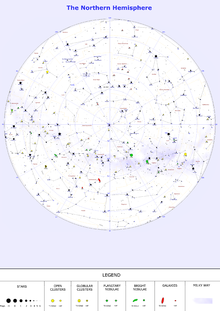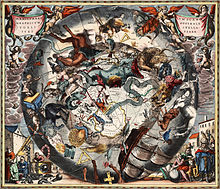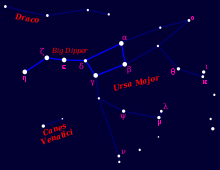Constellation
In today's astronomy, a constellation is a region of the starry sky that is delimited from other regions of the sky in relation to a train of bright stars that are visible to the naked eye (pattern recognition). For the view of the sky from the earth, the boundaries of 88 constellations were defined in spherical astronomy at the beginning of the 20th century by international agreement, with which the surface of the celestial sphere is divided up completely, so that celestial bodies can be easily identified.
With the naked eye, without any aids, only stars that belong to our galaxy, the Milky Way, can be seen in the night sky, with a few exceptions - such as the Andromeda Nebula. Bright stars were already used in the Neolithic Age for visual orientation, grouped together in asterisms and seen as figures, interpreted mythologically in early antiquity, and since antiquity have been assigned to mythical figures, animals or objects. A well-known example is the so-called Great Bear (Ursa maior) or a part of it as the Big Dipper, whose two box stars show the direction to the pole star.
The stars of such a constellation have relatively small angular distances to each other and are therefore relatively close to each other in the sense of the celestial coordinates of spherical astronomy. However, this proximity is only an apparent one. By measuring their parallaxes, the distance from the solar system can be determined for individual stars, and it can differ many times for the stars of a constellation (see, for example, the star list of Orion). Thus stars can have a greater distance to other stars of the same constellation than to the Sun. On the other hand, two stars of different constellations may actually be at a smaller distance from each other than seemingly closely spaced stars of the same constellation.
Constellations were an important means of orientation in many cultures and were particularly important for seafaring. Today they serve clearly defined mapping of the sky as well as the local assignment of objects. The International Astronomical Union (IAU) has defined the constellation boundaries according to celestial coordinates and uses them, among other things, to approximate the location of variable celestial objects such as meteors or novae. Constellations are also called constellations, not precisely defined constellations are called asterisms. This term also includes the historical constellations of Western astronomical history and the constellations of other cultures.
Constellations can be found in almost all cultures and can be traced back to the early advanced civilizations. Human-like figures (such as Orion), triangles to hexagons and longer star rows (such as Andromeda, five-star row, water snake) or star trains (dragon, snake, Eridanus) play a special role. Today's constellations go back to twelve Babylonian and ancient Egyptian signs of the zodiac, which were expanded to 48 in ancient Greece. Between 1600 and 1800 more were introduced. Since 1922, 88 internationally recognized constellations have been used, whose boundary lines were officially defined by the IAU in 1928 after preliminary work by Eugène Delporte.
Astrognosy is the field of astronomy that deals with constellations and star trains. The names of the constellations are important for the systematic naming of stars with Greek letters (Alpha, Beta, Gamma, ...) and Latin name of the constellation, e.g. Alpha Centauri.

The constellation "Archangel Michael" can be found in Julius Schiller's star atlas Coelum Stellatum Christianum

Interpretation of stone-age paintings in the cave of Lascaux as reference to celestial bodies in the summer triangle

Reproduction of the underlying scene-like representation
.jpg)
Constellations of the northern sky, 1515, depiction by Albrecht Dürer

Representation of the present constellations of the northern sky

Constellations of the Southern Sky, 1661, depiction by Andreas Cellarius
Definition constellation - asterism
An asterism (from Latin astrum from Greek ἄστρον astron "constellation, star, star") is the name given in astronomy to a group of (usually bright) stars which - linked by imaginary connecting lines ("asterisms") - form a conspicuous shape or figure in the sky. An asterism may be part of a constellation and consist of adjacent stars (examples include the Big Dipper as part of the constellation of the Big Dipper, or the "belt" of Orion); it may also include conspicuous stars of different constellations, such as the Summer Triangle or the Winter Hexagon, whose stars are distributed over a large part of the sky. Characteristic of an asterism is its conspicuousness, so faint, inconspicuous constellations are not asterisms. Occasionally, however, historical constellations that were once recorded on star charts, such as the constellation "Ship Argo", are called asterisms.
In addition, in the mapping systems of other cultures, such as ancient Indian or Chinese astronomy or that of the Mayas, there are constellations in which completely different figures are recognized.

The asterism Big Dipper in the constellation Big Dipper (Ursa Major "greater she-bear") is called Big Dipper in US English.

Ship Argo - a historical constellation of the southern sky - today divided into three smaller constellations
Meaning of the constellations
Constellations only present themselves subjectively to the observer. The impression that the stars of a constellation are close together in the sky is based on the projection effect.
The twelve signs of the zodiac, which go back to the Babylonian constellations of the ecliptic, form one of the foundations of astrology. However, since the constellations have since shifted by about 30 degrees due to precession against the zodiacal signs, they no longer coincide, and Western astrology generally rejects the interpretation based on actual constellations (sidereal astrology) (Zodiac).
Constellations and asterisms also appear in Greek teaching poems on the course of the year and agriculture, where they are used to divide the seasons.
In astronomy, constellations were already used in star catalogues from antiquity to indicate position. Still around 1800 star catalogues divide the celestial objects into constellations, but soon thereafter one goes over to a pure position indication with right ascension and declination. But the astronomical nomenclature of the visible stars in the Bayer/Flamsteed code of 1603 and 1712 apart from their trivial names is still based on this system of the areas of the starry sky, like for example Alpha Centauri after the constellation of the Centaur.
Despite their relatively minor importance today, constellations have lost none of their fascination for the observer of a dark starry sky and play an important role in the popularization of astronomy. The didactics of astronomy uses them - in connection with the associated star sagas - to inspire young people for "stargazing" and to introduce them to modern astronomy on the basis of historical developments.
Search within the encyclopedia